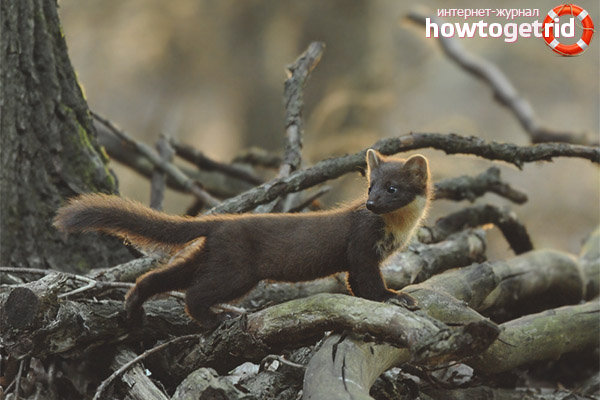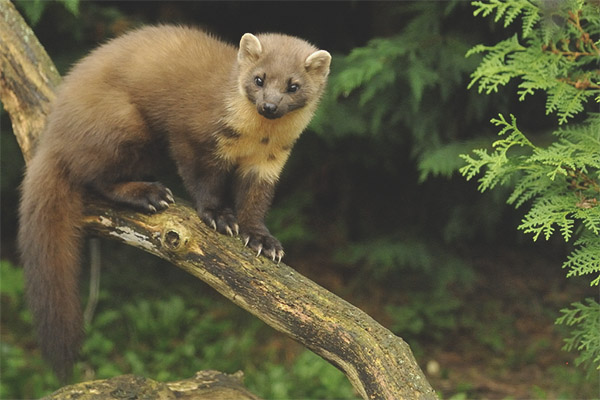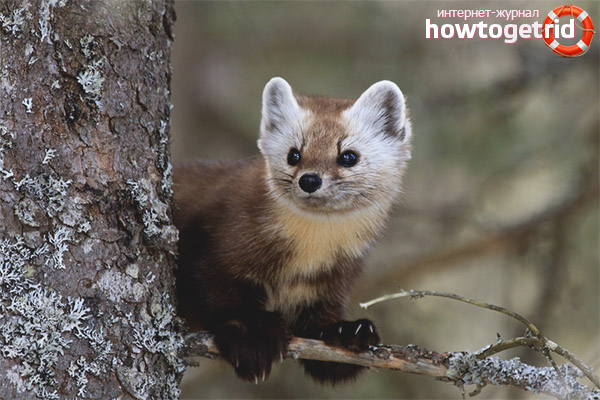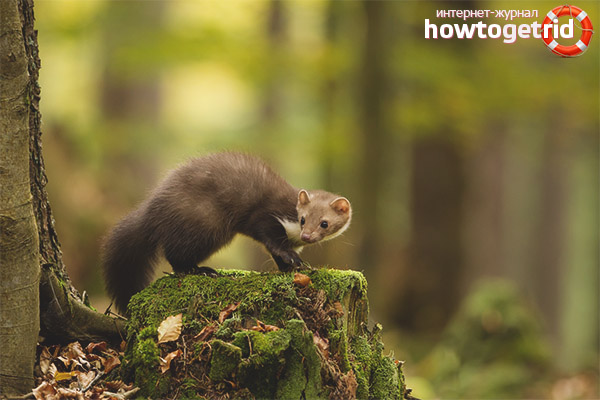The content of the article
The pine marten, which is also called the yellow-shelter, is a mammal predator. The animal has a long fur, which has considerable value. Externally, the marten looks elegant and graceful, its body is oblong.
The tail of the marten is fluffy, covered with fur, rather large, approximately equal in length to the body. The tail performs not only the role of decoration, but also is very functional - using it, the marten maintains balance while jumping or moving along the branches of trees.
The extremities of the animal are short, at the time of the winter cold they become more woolly. This allows the animal to easily run on the ice or snow deposits. Each of the paws ends with five fingers with curved claws, which can be pulled in by a half.
Muzzle of pine marten is long and wide, the animal has a strong jaw and very sharp teeth.Predator ears have a triangular shape, rather large relative to the muzzle. At the tip, they are rounded, the edging is yellow.
Nose marten black, pointed. The eyes are darkish, at night get a slightly copper color. When looking at a photo of the animal, you can experience the most positive emotions. Externally, the marten looks affectionately and harmlessly, its look innocent. Special attention is given to high-quality animal fur and amazing color.
The color of the coat of the animal can vary from chestnut and light brown to yellowish. On the back, legs and head, the fur usually has a darker shade than on the belly and sides. The tail on the end is most often black.
A characteristic external feature of the forest marten from other representatives of the breed is an orange shade of hair in the neck, which smoothly flows to the forelegs. It is from here that the other name of the animal takes its name - the yellow heart.
In size the marten is comparable to an adult large cat. The length of the body can reach 55 centimeters, the tail is usually about 26 cm. In comparison with an adult male, the female is less than a third.
Habitat
Practically all Eurasian forests are densely populated with pine martens. These animals live on a spacious territory: from the Caucasus and Iran, western Siberia and Corsica, to the lands of Asia Minor and Sicily, to the Mediterranean islands and Sardinia.
The animal often chooses forest areas with deciduous trees, sometimes mixed forests. Much less often they can be met in coniferous, flattering terrain. In exceptional cases, pine marten can live in the high mountains, but only where there are trees.
The ideal place to live for the animal are areas of forest where there are trees with hollow. The marten goes to the spacious and open areas only for the purpose of hunting. The territory where the rocky landscape prevails is not suitable for an animal.
This animal does not set up a separate and permanent dwelling for itself. Often the yellow-shelter is looking for hollows abandoned by squirrels, old nests, windbreaks, choosing places at a height of 5-6 meters. Here the marten stops in order to spend the rest of the day.
After evening and night, the graceful predator goes in search of food, and then goes to the next place to rest.However, if in the area where the marten lives, strong frosts come, its outlook may change. In this case, the animal for a long time lives in a dwelling, using for food what it has prepared in advance. Yellowfish prefers places far from people and settlements.
The value of the animal's fur is determined by the fact that the pine marten is the most important commercial species of the Mustelidae. Thus, the yellow-heel is experiencing sufficient difficulties with reproduction and survival. This is facilitated not only by the reduction of suitable forest animals for living, but also by an increase in the number of hunters who want to get expensive fur.
Character traits

In comparison with other representatives of the mustelid genus, the yellow-shelter relates most favorably and reverently to the habitat and the process of hunting directly on the trees. She has no problem needing to climb high up the tree trunks. A significant role in this is played by a tenacious and long tail, which the animal uses not only as a helm, but also as a kind of parachute, allowing you to jump from a height without injury.
The marten is not at all afraid of the very tops of the trees, it can easily move from branch to branch, and the maximum jump length of the animal can reach four meters. Even on the surface of the earth, it can also jump. In addition, marten is an excellent swimmer, but it can go into the water in exceptional cases.
The pine marten is distinguished by agility, dexterity and speed. The animal can cover vast distances in a short time. Many other predators will envy her keen eyesight, hearing and smell, which assist her in the hunting process. Yellowfish is quite funny, sweet and curious. In their own flock of martens they talk, using sounds that look like growling or purring. Cubs of these animals make sounds that resemble chirp.
Most of these animals prefer to live alone, apart from other members of this species. Each animal has its own personal plot. Marten demarcates its territory using special marks by smell, which are obtained due to secretions of an odorous secret from anal glands.The total area occupied by the animal territory can reach 5,000 hectares. Typically, females have a plot that is several times smaller than that of males. In addition, the area of the site may decrease with the onset of the cold season.
Males are engaged in active protection of their personal territory from other animals of this sex. In addition, some females and males "allotments" may intersect with each other. Also, if there are two males outside the rut period, this is usually not accompanied by clashes and aggression.
What feeds on pine marten
This animal is unpretentious in food, is an omnivorous predator. The diet of forest marten is completely and entirely determined by the time of the year, the habitat of its habitat and the ability to find this or that food. But, nevertheless, the main component of its food is food of animal origin. The most favorite dainty of pine marten are ordinary squirrels.
It often happens that a hunter manages to catch a squirrel right inside the hollow. However, if this does not happen, the marten can pursue prey for a long time, moving after it along the branches of the trees.There is also an impressive list of various small animals, for which the marten will gladly open its merciless hunt. These include both ordinary snails and wild hares and hedgehogs. It is noteworthy that the predator kills its prey by inflicting one exact bite on the back of its head. The animal will never shrink from carrion.
In summer and autumn, pine marten is actively engaged in replenishing its own organism with essential vitamins. She eats nuts, wild berries, fruits growing on trees and other products saturated with microelements. The yellow frame hides a certain amount of food obtained in the seized hollow for the future. Most of all this animal loves to eat rowan berries or blueberries.
Lifetime and reproduction
In the summer season, the rut begins at the forest marten. One adult male chooses one or two females for mating. It is curious that with the onset of winter, the so-called false rutting period may occur at martens. In this case, they also show anxiety, aggression and militancy, but this does not lead to the necessary mating.
Only after a little more than three weeks, the babies begin to hear sounds, and by the 28th day their eyes open. If the female has a need for hunting, she can leave the offspring for a certain time. In cases where he is in danger, the mother takes them to another, safe enough shelter.
By the age of four months, slightly mature animals can show autonomy and earn their own food, but for some time still keep near their own mother. The life of a pine marten on average reaches ten years, but in the most favorable situation it can be fifteen years.
Data
The pine marten is quite difficult to breed in an artificially created setting.The largest groups of these animals live in zoos, which are located in Germany and Austria. Also, some fans of funny predators keep them at home. However, it should be understood that it is not known how exactly marten will react to a person in a residential environment. Some representatives will be affectionate and gentle, others will react indifferently, and still others will begin to show a belligerent mood.
Despite their rapacity, some forest martens are rather timid and shy. At the moment of fright, they are subjected to a seizure, which proceeds with severe convulsions, in some cases, with convulsions. Then after a while the animal freezes. Most often, the seizure passes without a trace, but sometimes it ends in the death of a marten.
Yellowfish can be quite dangerous not only for other animals, but also for humans. The marten is a potential peddler of rabies, parasites and worms, and the plague. In addition, the marten occasionally raids on chicken coops.
In the list of enemies of this animal are other predators. These include a wolf, a lynx or an eagle owl, a fox and some birds, for example, a hawk or golden eagle.From the ground predators the marten can successfully hide in high trees. It is often the case that larger animal hunters kill yellowworms, not for the sake of food, but to eliminate a direct competitor in the food chain.
At the moment, the global population of forest martens has about 200 thousand heads. Also, it is curious that the yellowfish can mate with representatives of the sable species. In this case, the hybrid is fruitless, it is called Kindus.
Video: pine marten (Martes martes)













To send